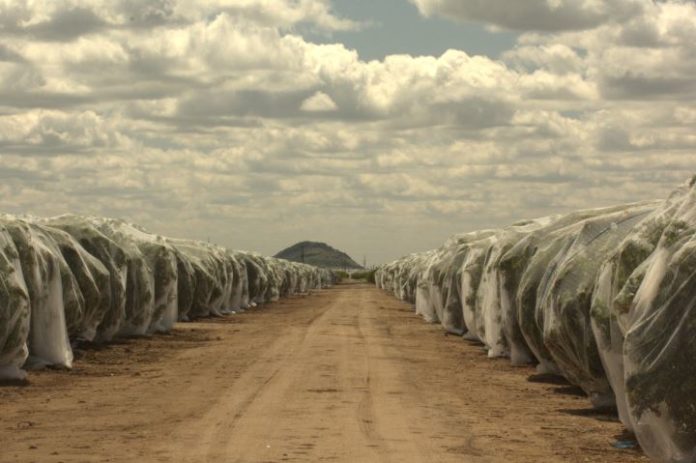 The Kaweah Delta Water Conservation District held its Tuesday, November 3, 2020 board meeting remotely from its Farmersville headquarters. Chairman Don Mills called the meeting to order at 9:00am. The consent calendar was passed and Water Master Vick Hernandez started things off with a bummer. The water year has not started off well on the supply side. It was a little difficult to understand him at first but he must have moved to a different location nearer the phone. He said the Hot Spot Ag sensor equipment has impressed him to no end. There have been some serious problems with snow measurements and this new technology may have some other applications. Let me be clear, Hot Spot wasn’t mentioned as a solution to monitoring snowpack but Hernandez liked the way it worked for monitoring the district’s water movement.
The Kaweah Delta Water Conservation District held its Tuesday, November 3, 2020 board meeting remotely from its Farmersville headquarters. Chairman Don Mills called the meeting to order at 9:00am. The consent calendar was passed and Water Master Vick Hernandez started things off with a bummer. The water year has not started off well on the supply side. It was a little difficult to understand him at first but he must have moved to a different location nearer the phone. He said the Hot Spot Ag sensor equipment has impressed him to no end. There have been some serious problems with snow measurements and this new technology may have some other applications. Let me be clear, Hot Spot wasn’t mentioned as a solution to monitoring snowpack but Hernandez liked the way it worked for monitoring the district’s water movement.
Snow Levels
General Manager Mark Larsen said the actuaries at the insurance companies have freaked  out over snow survey teams having to move around in the snow and coverage has become prohibitively expensive. There are three survey points mentioned Larsen mentioned as in jeopardy of having readings lost. If you can’t tell how much of a snowpack is present you can’t anticipate runoff and how to best manage storage for not just supplies but flood control as well. Larsen said he’s contacted neighboring districts about funding some alternate methods and they are willing to team up. The good news is whatever the local districts are having to pay for snow measurements will be deducted from the DWR bill since they are providing the service.
out over snow survey teams having to move around in the snow and coverage has become prohibitively expensive. There are three survey points mentioned Larsen mentioned as in jeopardy of having readings lost. If you can’t tell how much of a snowpack is present you can’t anticipate runoff and how to best manage storage for not just supplies but flood control as well. Larsen said he’s contacted neighboring districts about funding some alternate methods and they are willing to team up. The good news is whatever the local districts are having to pay for snow measurements will be deducted from the DWR bill since they are providing the service.
Mills asked about measuring snow by satellite and Larsen said they can measure depth but not water content. Studies have found the amount of water content per storm is pretty even. In other words a water content measurement will go a long ways to determining what conditions are in a watershed. A part of the problem is the Park Service won’t allow helicopter and other data gathering methods in wilderness areas. DWR puts out Bulletin 120 annually. It’s the official projection compiled from data readings throughout the state and the less reliable data the less accuracy.
Larsen said he and Hernandez have spoken with DWR about the Airborne Snow  Observatory flights. It’s expensive at $250,000 for three flights. NASA did the first flights and hasn’t established the actual cost. DWR is willing to cut a check for the $250,000 minus10-percent. But that leaves $400,000 of KDWCD’s money it has already invested in the program with DWR in an account. DWR said it can’t get the money to Kaweah Delta until it is presented with an invoice. DWR wants to apply the money to ASO flights for 2021-2022. There were other options but none of them reimbursed Kaweah Delta its money. DWR will just spend it for the district. KDWCD can’t even get the money to pay for snow sensor equipment and repairs. That comes out of a different fund. Larsen said an option looking better and better is to contract with ASO Incorporated through DWR. ASO Inc. is a new, private company taking over the ASO flights from NASA. It has had growing pains but seems to now be working out.
Observatory flights. It’s expensive at $250,000 for three flights. NASA did the first flights and hasn’t established the actual cost. DWR is willing to cut a check for the $250,000 minus10-percent. But that leaves $400,000 of KDWCD’s money it has already invested in the program with DWR in an account. DWR said it can’t get the money to Kaweah Delta until it is presented with an invoice. DWR wants to apply the money to ASO flights for 2021-2022. There were other options but none of them reimbursed Kaweah Delta its money. DWR will just spend it for the district. KDWCD can’t even get the money to pay for snow sensor equipment and repairs. That comes out of a different fund. Larsen said an option looking better and better is to contract with ASO Incorporated through DWR. ASO Inc. is a new, private company taking over the ASO flights from NASA. It has had growing pains but seems to now be working out.
Larsen said due to attrition, insurance, damaged equipment and other factors the vital data will be lost. Director Chris Tantau asked if the contract with DWR has been reviewed, he wants the district’s money back. Attorney Aubrey Mauritson said it would be most likely a situation requiring a lawsuit. Tantau said the money could be used to outfit new monitoring locations and while it could be used it might be more prudent fiscally to contract through  DWR with ASO Inc. Larsen said that would be his choice but with an agreement allowing considerations should some of the flights not take place. There is a scenario wherein a light dusting of snow could come through in early May and it wouldn’t be of any benefit to send up a flight. So three flights a year is a guide not a policy. Larsen said – if I understood him correctly – DWR staff in charge of snow surveys have busted it to get as much accomplished as possible and have been really good to work with. I’m pleased to hear some praise for the state, it’s rare. Good for DWR’s snow men and women.
DWR with ASO Inc. Larsen said that would be his choice but with an agreement allowing considerations should some of the flights not take place. There is a scenario wherein a light dusting of snow could come through in early May and it wouldn’t be of any benefit to send up a flight. So three flights a year is a guide not a policy. Larsen said – if I understood him correctly – DWR staff in charge of snow surveys have busted it to get as much accomplished as possible and have been really good to work with. I’m pleased to hear some praise for the state, it’s rare. Good for DWR’s snow men and women.
CVP Water
Engineer Dennis Keller reported on Central Valley Project supplies saying the Friant Kern Canal has stopped deliveries for repairs. Millerton Lake is doing better than expected if I understood him correctly. The operational interruptions from the Creek Fire have been dealt with upstream.
Tantau reported on Friant Water Authority matters. He serves as FWA Chair. Tantau said the Bureau will be the lead on the Friant Kern Canal repairs. Funding is the issue and the southern contractors want to get things going and are willing to put in money but they want extra capacity for doing so. FWA is in negotiations with GSAs about transitional pumping fees going towards FKC repairs.
About half the O&M costs FKC contractors pay goes to the San Luis Delta Mendota costs. That’s the Jones Pumping Plant, Delta Mendota Canal and the San Luis Reservoir. FWA is having a retreat later this month and will discuss this matter. Rewinding a pump at the Jones Plant is a multimillion dollar affair and there are five pumps.
Hannah Ranch South Project
Larsen reported the Hannah Ranch South project is going well. This is a basin upstream near Woodlake that will serve as a storage location. There will even be a turnout from the FKC. Keller put a Power Point presentation up on the boardroom screen. It was kind of a letdown for those of us viewing remotely as whatever Keller had on the boardroom screen, much like what happens in Las Vegas stayed on the boardroom screen. He had a mess of blueprints, I think, he showed how the turnout would be installed. The FKC will have a panel removed, the turnout installed and a new panel put back on to the canal.
At about this time I lost my connection and I’m confident the board and staff were able to carry on without me to a satisfactory conclusion of this meeting.
DISCLAIMER OF RESPONSIBILITY; Waterwrights.net strives to provide his clients with the most complete, up-to-date, and accurate information available. Nevertheless, Waterwrights.net does not serve as a guarantor of the accuracy or completeness of the information provided, and specifically disclaims any and all responsibility for information that is not accurate, up-to-date, or complete. Waterwrights.net’s clients therefore rely on the accuracy, completeness and timeliness of information from Waterwrights.net entirely at their own risk. The opinions expressed in this report are those of the author and do not represent any advertisers or third parties.
ALL RIGHTS RESERVED. Copyright 2020 by Don A. Wright
Kaweah Delta Water Conservation District
2975 N. Farmersville Blvd.
Farmersville, California 93223
559/747-5601
KDWCD is part or the Greater Kaweah GSA DWR #5-022.11
Board of Directors
Don Mills – President, Chris Tantau – Vice-President, Ron Clark, Jimi Valov, Jeff Ritchie, Mike Shannon & Brian Watte
Management
Mark Larsen, General Manager – mlarsen@kdwcd.com
Terry Stafford, Facilities Manager -tstafford@kdwcd.com
Dian Rader, Administrative/HR Coordinator – drader@kdwcd.com
Larry Dotson, Senior Engineer – ldotson@kdwcd.com
Shane Smith, Projects/Administrative Manager – ssmith@kdwcd.com
Office and Field Staff
Equipment Operators – Jesus Sandoval, Chris Bell
Water Master – Victor Hernandez
Office Assistant – Kathleen Halvorsen
Primary Consultants
Bruce George – Special Projects Consultant
Dennis Keller – Civil Engineer (Keller/Wegley Consulting Engineers)
Aubrey Mauritson – Attorney (Ruddell, Cochran, Stanton, Smith & Bixler, LLP)
From the Kaweah Delta website:
The Kaweah Delta Water Conservation District (KDWCD) was formed in 1927, under the provisions of California state law known as the Water Conservation Act of 1927, for the purpose of conserving and storing waters of the Kaweah River and for conserving and protecting the underground waters of the Kaweah Delta. Later the Water Conservation Act, as well as the purpose of the District, was expanded to include power generation and distribution.
The District is located in the south-central portion of the San Joaquin Valley and lies in portions of both Tulare and Kings Counties. The total area of the District is about 340,000 acres with approximately 255,000 acres located in the western portion of Tulare County and the balance, or 85,000 acres, in the northeastern portion of the Kings County.
The Districts lands are primarily agricultural in nature, although the cities of Visalia and Tulare constitute significant areas of urbanization. Farmersville is the other incorporated area. The population of the District is currently estimated to be in excess of 175,000 people with the principle crops being cotton, misc. field crops, deciduous fruit and nut trees as well as alfalfa.
Numerous public and private entities within the District’s boundaries divert water from the Kaweah River and its distributaries. Nearly all of the lands served with Kaweah River water also are served irrigation water from groundwater, primarily due to the erratic and relatively undependable nature of flow on the Kaweah River. All municipal and industrial water uses within the District are supplied from groundwater.
KDWCD and Tulare Irrigation District (TID), which lies entirely within the boundaries of the Kaweah Delta Water Conservation District, has a long-term contract with the federal Central Valley Project (CVP) for water from the Friant Division of the CVP. TID has historically received substantial quantities of CVP water surplus to the demands of the District which augment the Kaweah River supply.
The District and the Kaweah River groundwater basin have experienced long-term groundwater overdraft estimated in 2007 to be as much as 40,000 acre-feet per year. The District has performed multiple studies of groundwater data to determine the extent and volume of groundwater overdraft within its boundaries. There are currently over 40 recharge basins within the District covering approximately 5,000 acres. While KDWCD owns and operates many of these groundwater recharge basins, it does not provide water banking services for others.






























